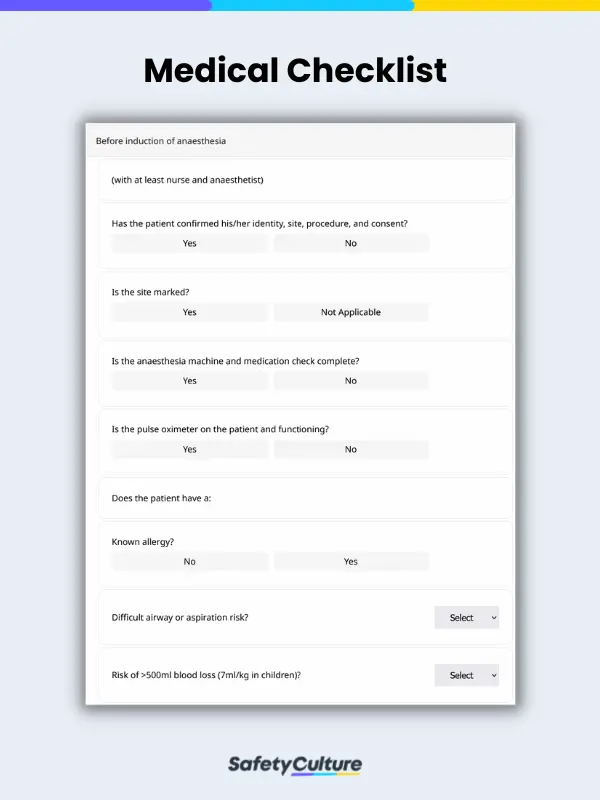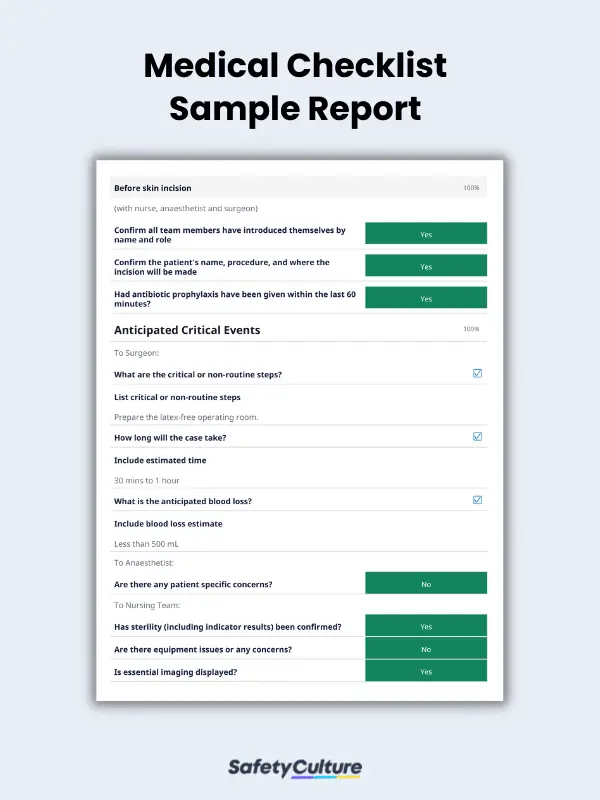What is a Medical Checklist?
A medical checklist is an itemized document used for various procedures and protocols in healthcare settings. It functions as a guide for carrying out medical procedures safely and correctly, whether a physical examination or a surgical operation. Using this checklist, healthcare professionals can provide the best possible care for their patients.
Benefits
Medical checklists are a vital part of any medical practice. For instance, they outline the steps in carrying out medical processes in a clear and concise manner that healthcare staff can easily follow. With the help of this tool, medical professionals can perform all crucial steps accurately and account for all necessary items in a procedure without missing anything. This way, they can minimize deadly errors and maximize patient safety.
A medical checklist also helps improve communication and coordination between providers and patients. It ensures that all healthcare team members are aware of the patient’s condition and treatment plan and can help to prevent or catch errors, especially for high-risk operations. In fact, various studies suggest the effectiveness of using checklists in medical environments, as it has enabled providers to deliver quality patient care and improve outcomes in various settings, such as the operating room and the intensive care unit (ICU).
Types
Medical checklists come in different kinds depending on the situation and intended purpose. Some of its most common types and uses include:
- General medical checklist – used to improve the safety of standard medical procedures such as surgical operations from the pre-operative to the post-operative phases.
- Medical history checklist – used to collect all relevant patient information during the history-taking process; a great tool for tracking patient progress and proactively spotting health problems.
- Medical audit checklist – used to verify if specific areas and procedures (e.g., clinical services, nursing care, and medication) are carried out accurately and in accordance with the set guidelines and protocols
- Administrative form – used to check if patient transfers, discharges, laboratory testing, and other procedures are carried out as intended.
- Compliance checklist – used to confirm if healthcare providers follow regulations and standards for patient care, data privacy, and medical records from agencies such as the Occupational Safety and Health Administration (OSHA), Health Insurance Portability and Accountability Act (HIPAA), and the Care Quality Commission (CQC).
- Hospital safety inspection checklist – used to promote safety in the medical premises, including proper housekeeping and cleaning procedures.
- Clinical audit checklist – used to review clinical outcomes and patient care against industry standards and established benchmarks.
What to Include in a Medical Checklist
A medical checklist is a great way to organize and keep track of procedural instructions and vital patient information. Each checklist will contain different information based on its function and setting, but in general, it’s essential to include the following information when creating one:
- Title Page – This section specifies the date, time, and the people or team involved in the procedure or check-up. It can also include the patient’s name, contact information, medical history, current conditions, and treatments, as well as any allergies.
- Pre-operative Check – This section lists essential tasks before starting a consultation, procedure, or laboratory test. For example, if it’s for a surgical operation, the checklist must indicate things to do before inducting anesthesia and creating a skin incision.
- Operational Procedure – This section outlines the required steps to be performed and anticipated critical events during a medical procedure or testing. It ensures that the process goes as planned without missing any vital points.
- Post-operative Check – This section runs through a series of tasks to be completed after performing the procedure and before discharging the patient. For example, a medical checklist for surgical operations can verify if the instrument count, specimen labeling, and equipment check are accomplished before the patient leaves the operating room.
- Sign-off – This section gives the physician, nurse, or other healthcare staff in charge a space to note their observations during the medical procedure and affix their signature as proof of completion.
Here is a sample report of a medical checklist for surgical operations, completed using a digital tool:
FAQs about Medical Checklists
In some countries, the use of medical checklists for surgical procedures is mandated by law. For example, all hospitals under the National Health Service (NHS) in the United Kingdom must follow the guidelines set in the WHO Safe Surgery Checklist. But whether required or not, medical checklists are powerful instruments for safely carrying out medical procedures.
Maximize the use of medical checklists using the following tips:
- Tailor the checklist to the specific setting and procedure.
- Structure it in such a way that is easy to use and understand.
- Regularly update the checklist to reflect changes in medical best practices.
- Train staff members on how to use the checklists effectively.
- Integrate medical checklists into a broader safety program for healthcare settings.
Among the common challenges when creating and using paper-based medical checklists are as follows:
- Tailoring checklists according to the ever-changing requirements
- Taking too much time to create and replicate checklists manually
- Feeling the burden of checking off items from the checklist (known as “checklist fatigue”)
- Lacking means to establish accountability in accomplishing these forms
- Having the risk of losing, damaging, or destroying these documents




